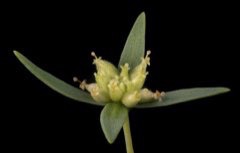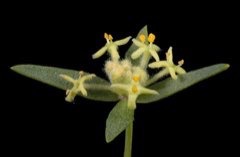 |
|
Kevin Thiele from Perth, Australia |
 |
| Kevin Thiele from Perth, Australia |
Translate this page:
Summary
Physical Characteristics

 Pimelea microcephala is an evergreen Shrub growing to 4.5 m (14ft 9in).
Pimelea microcephala is an evergreen Shrub growing to 4.5 m (14ft 9in).
See above for USDA hardiness. It is hardy to UK zone 9. It is in leaf all year. The species is dioecious (individual flowers are either male or female, but only one sex is to be found on any one plant so both male and female plants must be grown if seed is required). . The plant is not self-fertile.
Suitable for: light (sandy) and medium (loamy) soils and prefers well-drained soil. Suitable pH: mildly acid and neutral soils and can grow in very acid soils.
It cannot grow in the shade. It prefers dry or moist soil.
UK Hardiness Map
US Hardiness Map
Synonyms
Plant Habitats
Woodland Garden Sunny Edge;
Edible Uses
Edible Parts: Fruit
Edible Uses:
Fruit[173]. There are concerns about the toxicity of the fruit - please see readers comments below.
References More on Edible Uses
Medicinal Uses
Plants For A Future can not take any responsibility for any adverse effects from the use of plants. Always seek advice from a professional before using a plant medicinally.
None known
References More on Medicinal Uses
The Bookshop: Edible Plant Books
Our Latest books on Perennial Plants For Food Forests and Permaculture Gardens in paperback or digital formats.

Edible Tropical Plants
Food Forest Plants for Hotter Conditions: 250+ Plants For Tropical Food Forests & Permaculture Gardens.
More

Edible Temperate Plants
Plants for Your Food Forest: 500 Plants for Temperate Food Forests & Permaculture Gardens.
More

More Books
PFAF have eight books available in paperback and digital formats. Browse the shop for more information.
Shop Now
Other Uses
Fibre
A tough fibre obtained from the stems is used as a tying material and for cordage[154, 156].
Special Uses
References More on Other Uses
Cultivation details
We have very little information on this species and do not know if it will be hardy in Britain. The following notes are based on the general needs of the genus. Prefers a lime-free peaty well-drained loam[1, 200] in a sunny position[188]. Rather slow growing[200]. Flowers are produced on the tips of the previous seasons growth. Plants may suffer from sudden die back. Dioecious. Male and female plants must be grown if seed is required.
References Carbon Farming Information and Carbon Sequestration Information
Temperature Converter
Type a value in the Celsius field to convert the value to Fahrenheit:
Fahrenheit:
The PFAF Bookshop
Plants For A Future have a number of books available in paperback and digital form. Book titles include Edible Plants, Edible Perennials, Edible Trees,Edible Shrubs, Woodland Gardening, and Temperate Food Forest Plants. Our new book is Food Forest Plants For Hotter Conditions (Tropical and Sub-Tropical).
Shop Now
Plant Propagation
Seed - we have no information on this species but suggest sowing the seed in a greenhouse as soon as it is ripe in the autumn if this is possible, otherwise in early spring. When they are large enough to handle, prick the seedlings out into individual pots and grow them on in the greenhouse for at least their first winter. Plant them out into their permanent positions in late spring or early summer, after the last expected frosts. Give the plants some protection from the cold for at least their first winter outdoors. Cuttings of half-ripe wood with a heel, July/August in a frame[200]. Softwood cuttings 5cm long in late spring[200].
Other Names
If available other names are mentioned here
Native Range
AUSTRALASIA: Australia (New South Wales (w. & c.), Queensland (south & central), South Australia, Victoria (n.w. & c.), Western Australia (south & central), Northern Territory (south))
Weed Potential
Right plant wrong place. We are currently updating this section.
Please note that a plant may be invasive in one area but may not in your area so it's worth checking.
Conservation Status
IUCN Red List of Threatened Plants Status :

Growth: S = slow M = medium F = fast. Soil: L = light (sandy) M = medium H = heavy (clay). pH: A = acid N = neutral B = basic (alkaline). Shade: F = full shade S = semi-shade N = no shade. Moisture: D = dry M = Moist We = wet Wa = water.
Now available:
Food Forest Plants for Mediterranean Conditions
350+ Perennial Plants For Mediterranean and Drier Food Forests and Permaculture Gardens.
[Paperback and eBook]
This is the third in Plants For A Future's series of plant guides for food forests tailored to
specific climate zones. Following volumes on temperate and tropical ecosystems, this book focuses
on species suited to Mediterranean conditions—regions with hot, dry summers and cool, wet winters,
often facing the added challenge of climate change.
Read More
Expert comment
Author
R.Br.
Botanical References
154
Links / References
For a list of references used on this page please go here
Readers comment